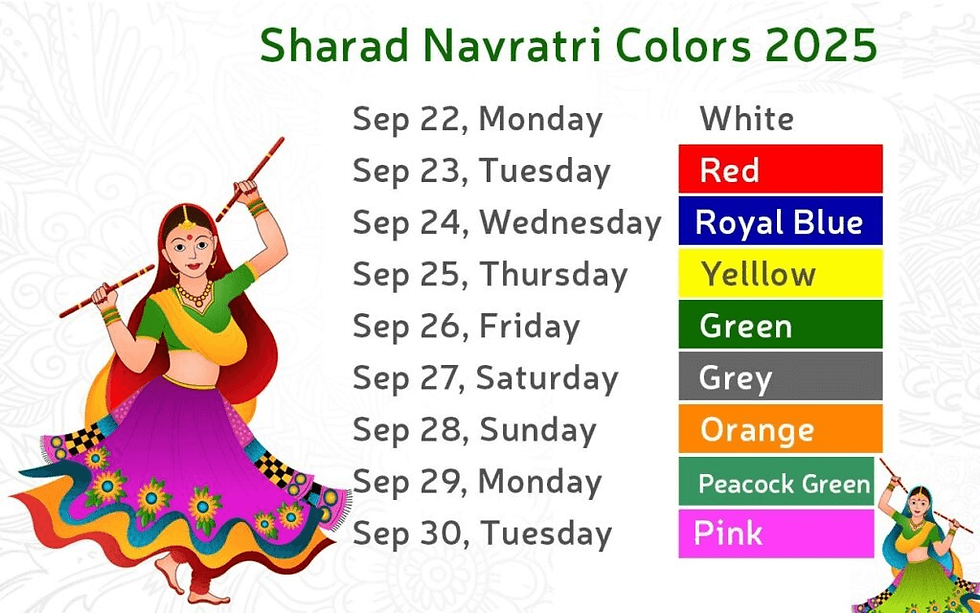Navratri 2025: Complete Guide to 9 Days and 9 Goddesses : Significance, Colors, and Spiritual Meaning
- Divangna Chawla
- Sep 23
- 3 min read
Navratri stands as one of India's most sacred festivals, a divine celebration spanning nine days and nine nights dedicated to worshipping Goddess Durga in her various forms. This magnificent festival commemorates the eternal battle between righteousness and evil, celebrating the ultimate triumph of Goddess Durga over the demon Mahishasura. The festival embodies the victory of good over evil through rituals, periods of reflection, fasting, and traditional dancing that connect devotees to the divine feminine energy.

Each day of Navratri honors a specific incarnation of the divine feminine, with unique stories, meanings, and associated colors that vary annually. The spiritual journey begins on the first day with Shailaputri, the daughter of the Himalayan ruler, whose legend symbolizes the commencement of the spiritual path. Mountains represent new beginnings, and she embodies strength, patience, and devotion, traditionally associated with the color white.
The second day celebrates Brahmacharini, the unmarried form of Goddess Parvati, renowned for her extraordinary penance and self-control in her determined pursuit to win Lord Shiva's heart. Her story exemplifies unshakeable determination and focused concentration for achieving greater purposes, symbolized by the color red. Chandraghanta graces the third day as the married form of Parvati, distinguished by the crescent moon bell adorning her forehead. This warrior goddess represents courage and the readiness to battle evil and negativity, associated with royal blue.

Kushmanda receives worship on the fourth day as the goddess credited with creating the universe through her divine smile, making her the embodiment of all energy and a symbol of new growth and life nurturing. Yellow represents her divine essence. The fifth day honors Skandamata, the protective mother of Kartikeya, whose story celebrates pure maternal love. Often depicted holding her son, she represents the selfless love and protection that mothers provide, symbolized by green.
Katyayani commands reverence on the sixth day as the warrior goddess of justice, born from the collective rage of gods specifically to combat demon Mahishasura. Her legend represents fierce determination dedicated to destroying evil and injustice, associated with grey. The seventh day brings worship of Kaalratri, the most fearsome incarnation of Goddess Durga, characterized by her terrifying appearance and dark complexion. She destroys all negativity, evil, and ignorance, symbolizing the power that eliminates darkness, represented by orange.
Mahagauri receives adoration on the eighth day as a unified and peaceful form of the goddess, representing purity, peace, and forgiveness after ending her terrible wars. Her narrative demonstrates the transformative power of purification and peace following conflict, symbolized by peacock green. The ninth and final day celebrates Siddhidatri, the ultimate form of the goddess representing perfection and spiritual achievement. She grants all magical powers and success, guiding followers toward the pinnacle of their spiritual journey, associated with pink.
Navratri transcends mere celebration to become an intense spiritual experience unfolding over nine transformative nights. Each goddess form carries profound stories that remind devotees of life's feminine powers - Shailaputri, Brahmacharini, Chandraghanta, Kushmanda, Skandamata, Katyayani, Kaalratri, Mahagauri, and Siddhidatri - encompassing nurturing qualities while granting wisdom and destroying evil. The festival's emphasis on divine feminine energy inspires inner strength and devotion among countless followers while encouraging virtuous living.
This cultural and religious celebration reinforces fundamental ideals while highlighting the eternal truth that good conquers evil and showcasing the everlasting strength of the goddess. Navratri serves as a powerful reminder of the divine feminine's role in spiritual growth, protection, and the ultimate triumph of righteousness over darkness.







Comments